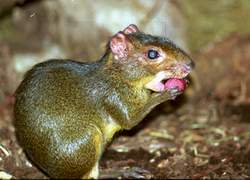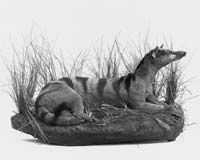Articles and reports from the Life Sciences and chemistry area deal with applied and basic research into modern biology, chemistry and human medicine.
Valuable information can be found on a range of life sciences fields including bacteriology, biochemistry, bionics, bioinformatics, biophysics, biotechnology, genetics, geobotany, human biology, marine biology, microbiology, molecular biology, cellular biology, zoology, bioinorganic chemistry, microchemistry and environmental chemistry.

Trees are better off if they produce large nuts. This is revealed in research by Patrick Jansen from Wageningen University. Scatterhoarding rodents appear to prefer burying larger nuts for later. The bigger the nut, the further it is buried from the tree and the more frequently it is forgotten.
Biologist Patrick Jansen investigated what happened to nuts as soon as they fell on the ground of the rainforest in French Guyana. He placed thousands of nuts on the ground in the forest. Each nut wa

Ames Laboratory researcher’s microscale channels steer neurons to rewire damaged nerves
Using microscale channels cut in an ultrathin biodegradable polymer, a researcher at the U.S. Department of Energy’s Ames Laboratory is working to regrow nerve cells. The technique, which may one day allow the paralyzed to walk and the blind to see, has been proven to work for peripheral nerve regeneration in laboratory rats.
Nerve cells are unlike most other biological tissue. When a

The number of circulating endothelial progenitor cells in an individual’s blood –– the precursor cells to those that line the insides of blood vessels –– may be an indicator of overall cardiovascular health, according to research by scientists at the National Heart, Lung, and Blood Institute (NHLBI) and Emory University School of Medicine. The research was published in the Feb. 13 issue of the New England Journal of Medicine.
The endothelial cells lining the blood vessels provide essen

Answer one of natural history’s most intractable questions
All of Madagascar’s living Carnivora (an order of mammals that includes dogs, cats, bears, hyenas and their relatives) descended from a single species that dispersed from Africa to Madagascar, apparently floating across the ocean barrier aboard wayward vegetation about 24 million to 18 million years ago. Previously, scientists believed that Madagascar’s seven living species of native Carnivora represented two to four

A gene discovered by Temple University researchers a decade ago has proved to be multi-functional, with the discovery of its important roles in cell differentiation, HIV transcription, and tumorigenesis.
Cdk9 (cyclin-dependent kinases) and cdk10 were originally isolated by Antonio Giordano, M.D., Ph.D., then a researcher in Temple’s Fels Cancer Institute, and his team in 1992. They are members of a family of kinases originally referred to as a PITALRE, which is the name of the amino aci

Researchers in Oxford University’s Department of Inorganic Chemistry have devised a novel method for separating polar organic compounds, providing a useful alternative to the usual methods of chromatography or crystallisation.
The separation of mixtures of organic and inorganic compounds is of considerable importance in most areas of industrial and academic chemistry. In particular, isomeric mixtures are often difficult to separate and can require highly specialised techniques.
Con